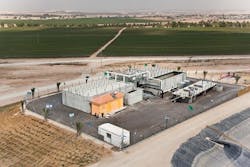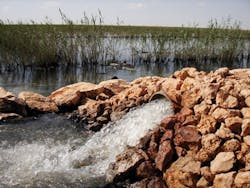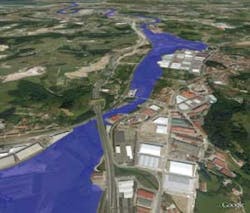Mapping Africa's Congo River Basin
A research project set out to collect data from the Republic of Congo's river basin. Faced with extreme weather changes, not to mention rainy season, the project team embarked to take water samples to test and quantify nitrogen, phosphorous and dissolved organic carbon levels. The following looks at how GIS technology was used.
The Congo River Basin in Africa, is the world's second largest river systems and one of the most important when it comes to understanding the global carbon budget. It was in November 2010 when scientists from the Woods Hole Research Center (WHRC) embarked on an expedition to collect water data from the Congo River Basin.
Supported by the National Science Foundation, the project, known as the Global Rivers Project, is a collaboration of several institutions around the world and focuses on six globally significant river systems: the Congo, Yangtze, Brahmaputra, Ganges, Kolyma, and Fraser. The programme brings together a selection of scientists, including geologists, geochemists, hydrologists, engineers and remote-sensing experts, to explore the relationship between river chemistry and large-scale land-cover characteristics.
Within the Republic of Congo, the team traveled by four-wheel-drive truck on a southwest–northeast transect, covering 1,400 kilometers (roughly the distance from Massachusetts to North Carolina) through rough terrain, poor roads, insects, and days of soggy weather countered by days of stifling heat. November is the rainy season in the Congo, which was the main reason the trip was planned for that time. High-flowing rivers and wetlands at their peak created an ideal contrast between the sampled water chemistry from this trip and that from previous excursions taken in the dry season.
One of the key measurements was dissolved organic carbon (DOC), a key indicator of land disturbance and land-cover changes worldwide. In addition to DOC, water samples were analysed for a variety of other constituents including dissolved and particulate forms of nitrogen and phosphorus, as well as temperature, salinity, pH, and a selection of dissolved gases.
As with any statistical modeling, diversity is important in the sample set. Geographic Information System (GIS) technology was used to find easily accessible major waterways where the areas of contribution (upstream watershed) covered the most diverse set of land-cover types available in the Republic of Congo. Latitude-longitude coordinates for each sample point were captured using GPS and mapped regularly.
The Congo River Basin has the largest swamp forest in the world. It is where the team spent the majority of time collecting data. Team members traversed these forests in a pirogue (wooden dugout canoe), sampling water along the way. Despite the hardship of the journey, they were happy to encounter a variety of land-cover types: grasslands and croplands in the south, sparse forest areas in the nation's midsection, dense humid forests in the north, and finally swamp forests in the ortheastern area of the country.
The team's goal was to collect data on each land-cover type in the basin as well as samples from tributaries feeding those areas. In preparation for the trip, spatial data was collected and loaded onto a laptop. As well as preparing GIS layers, Greg Fiske, GIS researcher and GIS manager at the WHRC created a script that would take the location points, calculate the upstream area, and produce a selection of land-cover metrics within that area based on key remotely sensed GIS layers.
At the end of each day, Fiske uploaded the geocoded water sample data to his laptop running Esri's ArcGIS software. He overlaid water sample and land-cover type attributes on the remote-sensing data so the team could immediately see the results of its work and affirm that it was in the appropriate location. GIS brought together, on the fly, the sample points/locations and the spatial data. Using these tools and the custom scripts, at the river's edge, the team could click a button and query the GIS about the size of the upstream contributing area or what the percentage of tree cover or other key land-cover types may be.
GIS software was used daily to plot sample locations
The challenge that made mapping difficult, and sometimes made fieldwork impossible, was the intense rain and the river waters. Fiske and other members of the team were constantly concerned about dropping gear into the river or losing it to the water in the bottom of a flooded pirogue. Sensitive gear was protected in waterproof bags and hard cases. Data was backed up on a USB-powered Passport external hard drive that was well secured in a watertight case.
The team had other duties besides data collection. The team worked with local people and trained them to collect water samples and metrics. This would allow the scientists to retrieve critical time-series information on the tributaries of the Congo.
Upon returning to the U.S., the team provided data and samples to associates who would use them to further study the attributes and relationships within the basin. Collectively, the members hope to reveal just how important dissolved organics and other key elements can be in detecting the impacts humans have on the land of the Congo River Basin. Their findings will provide the basis for understanding the health of a watershed and directing future watershed management.
Using GIS tools for this project, the team has been able to share data with others and distribute commonly used base layers. Fiske to date has posted project-wide base layers, such as stream networks, sample locations and watershed boundaries. Fiske and others are also designing spatial models to show correlations of certain land-cover types and water chemistry variables. The aims is being able to extrapolate the rules defined by the Congo analysis to other portions of tropical Africa—places that would be much more difficult to go to and physically sample. WWi
More Water & WasteWater International Archives Issue Articles




